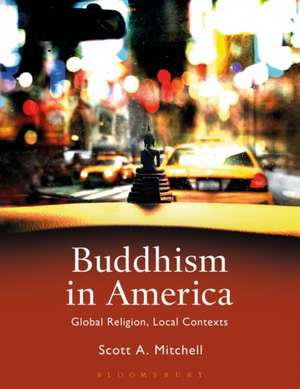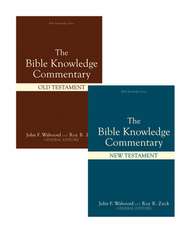Buddhism in America: Global Religion, Local Contexts
Autor Scott A. Mitchellen Limba Engleză Paperback – 19 oct 2016
| Toate formatele și edițiile | Preț | Express |
|---|---|---|
| Paperback (1) | 177.18 lei 6-8 săpt. | |
| Bloomsbury Publishing – 19 oct 2016 | 177.18 lei 6-8 săpt. | |
| Hardback (1) | 660.95 lei 6-8 săpt. | |
| Bloomsbury Publishing – 19 oct 2016 | 660.95 lei 6-8 săpt. |
Preț: 177.18 lei
Preț vechi: 214.35 lei
-17% Nou
Puncte Express: 266
Preț estimativ în valută:
33.91€ • 35.27$ • 27.99£
33.91€ • 35.27$ • 27.99£
Carte tipărită la comandă
Livrare economică 14-28 aprilie
Preluare comenzi: 021 569.72.76
Specificații
ISBN-13: 9781472581938
ISBN-10: 1472581938
Pagini: 320
Ilustrații: 39 b&w
Dimensiuni: 169 x 244 x 23 mm
Greutate: 0.59 kg
Editura: Bloomsbury Publishing
Colecția Bloomsbury Academic
Locul publicării:London, United Kingdom
ISBN-10: 1472581938
Pagini: 320
Ilustrații: 39 b&w
Dimensiuni: 169 x 244 x 23 mm
Greutate: 0.59 kg
Editura: Bloomsbury Publishing
Colecția Bloomsbury Academic
Locul publicării:London, United Kingdom
Caracteristici
Pedagogical features include chapter summaries, discussion questions, case studies, timelines, 40 images and maps, and a glossary; online resources include additional case studies and weblinks
Notă biografică
Scott A. Mitchell is the Dean of Students and Faculty Affairs and holds the Yoshitaka Tamai Professorial Chair at the Institute of Buddhist Studies, Berkeley, California, USA.
Cuprins
AcknowledgementsFiguresIntroduction: convergence and divergencePart One: Histories1. A Very Short Introduction to Buddhism 2. Nineteenth Century Foundations3. From Acculturation to the Counterculture4. Diversity and Pluralism at the Century's EndPart Two: Traditions5. Theravada Traditions6. Mahayana Traditions7. Vajrayana Traditions8. Post-modern Horizons?Part Three: Frames 9. Buddhist Medias: Art, Practice, and Representation10. Buddhist Identities: Race, Gender, and Sexuality11. Buddhist Engagements: Confronting Environmental and Social Suffering 12. Buddhist Modernities: US Buddhism in its Global ContextGlossaryBibliographyIndex
Recenzii
Unlike some textbooks, Buddhism in America offers both excellent content and a methodologically astute analysis. Despite the sophistication of the analytical methods, the book is written in clear language that most students are likely to understand. Undergraduates, graduate students, general readers, and non-specialists will all find the book engaging and informative.
Mitchell has accomplished the herculean task of assembling the rich and multiple histories of Buddhism in America into one cohesive whole without neglecting any of the central strands that constitute its many forms. The text elucidates past and present Buddhist landscapes in the U.S. within their wider global context, and also tracks the dissemination of the tradition in secular spaces. It is essential reading for both students and researchers of Buddhism in the West.
Mitchell's introduction to Buddhism coherently articulates foundational Buddhist teachings and practices as they are embedded in their cultural contexts, and he takes students along a journey of tracing the networks of Buddhist traditions intersecting in America. With its clear writing, explanations of philosophical content, and significant pedagogical tools, Mitchell's text provides a useful device for students in diverse educational settings that will draw them into the localization of Buddhism(s) in its vast variety.
It is sometimes noted that in the history of the Buddhist tradition, the case of Buddhism in America provides a historically unique situation in which the various Buddhist traditions of the world may now interact with one another. The rich diversity of this fascinating environment, however, makes its study all the more challenging. In Buddhism in America: Global Religion, Local, Mitchell covers an impressive range of Buddhist traditions, concepts, and practices in the United States, thus making it possibly the best resource available, for undergraduate teaching or graduate student examination preparation, in the area of American Buddhist studies. Moreover, I think that this book will become the first stop for those scholars (such as myself) who work on premodern Asian Buddhist traditions, but who are interested in working on topics related to Asian religions in the US.
The study of Buddhism in America draws from so many cultural, geographic, historical, and sectarian traditions that it can easily become unwieldy and its subjects flattened into two-dimensional characters, yet Mitchell's expert presentation remains accessible, engaging, and in touch with living traditions and their adherents. This volume, the first textbook of its kind on the subject, is sure to become a classic in the emerging field of Buddhism in the West. Students will benefit from Mitchell's depth and breadth of coverage while being guided toward a deeper engagement with the material. I will certainly be using this textbook in my courses.
Mitchell has accomplished the herculean task of assembling the rich and multiple histories of Buddhism in America into one cohesive whole without neglecting any of the central strands that constitute its many forms. The text elucidates past and present Buddhist landscapes in the U.S. within their wider global context, and also tracks the dissemination of the tradition in secular spaces. It is essential reading for both students and researchers of Buddhism in the West.
Mitchell's introduction to Buddhism coherently articulates foundational Buddhist teachings and practices as they are embedded in their cultural contexts, and he takes students along a journey of tracing the networks of Buddhist traditions intersecting in America. With its clear writing, explanations of philosophical content, and significant pedagogical tools, Mitchell's text provides a useful device for students in diverse educational settings that will draw them into the localization of Buddhism(s) in its vast variety.
It is sometimes noted that in the history of the Buddhist tradition, the case of Buddhism in America provides a historically unique situation in which the various Buddhist traditions of the world may now interact with one another. The rich diversity of this fascinating environment, however, makes its study all the more challenging. In Buddhism in America: Global Religion, Local, Mitchell covers an impressive range of Buddhist traditions, concepts, and practices in the United States, thus making it possibly the best resource available, for undergraduate teaching or graduate student examination preparation, in the area of American Buddhist studies. Moreover, I think that this book will become the first stop for those scholars (such as myself) who work on premodern Asian Buddhist traditions, but who are interested in working on topics related to Asian religions in the US.
The study of Buddhism in America draws from so many cultural, geographic, historical, and sectarian traditions that it can easily become unwieldy and its subjects flattened into two-dimensional characters, yet Mitchell's expert presentation remains accessible, engaging, and in touch with living traditions and their adherents. This volume, the first textbook of its kind on the subject, is sure to become a classic in the emerging field of Buddhism in the West. Students will benefit from Mitchell's depth and breadth of coverage while being guided toward a deeper engagement with the material. I will certainly be using this textbook in my courses.












